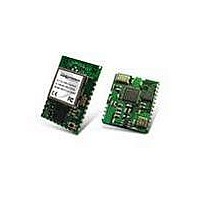WI.232FHSS-250-R Radiotronix, WI.232FHSS-250-R Datasheet - Page 14

WI.232FHSS-250-R
Manufacturer Part Number
WI.232FHSS-250-R
Description
RF Modules & Development Tools 900MHz FHSS Low
Manufacturer
Radiotronix
Datasheet
1.WI.232FHSS-25-FCC-RA-R.pdf
(67 pages)
Specifications of WI.232FHSS-250-R
Lead Free Status / RoHS Status
Lead free / RoHS Compliant
Other names
WI232FHSS-250-R
WI.232FHSS-25-R/ WI.232FHSS-250-R DATASHEET
to the UART for transmission to the host microprocessor. If not, it will resume scanning for another master.
If the packet received is a synchronizing packet, synchronization will be dropped if the packet address
validation fails.
Once the UART has buffered enough data to send (either
expired), it will schedule a transmission with the RF layer. The RF layer will make a best-effort attempt to
keep the data in at least regUARTMTU-sized packets, but will split data to better fill the communications
channel if the hop time allows. If the module is not synchronized at the time of the transmission, it votes
itself to master status, and sends a synchronizing preamble. Following a hop, the module that sends the
first transmission will vote itself to master status, send a synchronizing preamble, and communications will
resume.
2.3. Low-Power States
The module supports three power saving modes: Standby, Sleep, and Deep Sleep. Standby and Sleep
are included primarily for legacy compatibility with Wi.232DTS™ and Wi.232EUR™ products. The
hardware required to support these two low-power modes fully is not present in the Wi.232FHSS modules.
As a result, the current consumption in these two modes is considerably higher than their
Wi.232DTS™/Wi.232EUR™ counterparts. It is recommended that applications utilize the Deep Sleep
mode for power savings.
In the SLEEP and DEEP SLEEP modes, the transceiver is powered down and will not synchronize with
other modules. SLEEP mode draws more current than DEEP SLEEP mode. In DEEP SLEEP mode the
module draws the least current. To wake the module up from this mode the C2CK/RST pin must be held
low for at least 20μs and then returned to high. Modules do not monitor the receive channel in either
SLEEP or DEEP SLEEP mode. Therefore, it is impossible to remotely wake a sleeping module via the RF
interface.
If
once awakened from a low-power mode or power-off state. This indicates that the module is ready to
resume operations.
The following table indicates the states of the module pins while in a low-power state.
regACKONWAKE
Table 1, Wi.232FHSS Low-Power Pin States
Pin Name
250-R
PROC_PKT
TxD
NC
NC
NC
C2CK/RST
C2D
NC
CMD_RSP
EX
RSSI
CMD
BE
NC
RTS
CTS
RxD
Pin
Number
250-R
1
2
3
4
5
6
7
8
9
10
14
15
16
17
18
19
20
is enabled, the module will transmit a 0x06 character out the TxD pin of the UART
Pin
Number
25-R
N/A
6
N/A
N/A
N/A
11
10
N/A
8
2
9
4
3
N/A
N/A
7
5
Pin State
Driven Low
Input with weak pull-up
Input with weak pull-up
Floating
Floating
Input with weak pull-up
Input with weak pull-up
Floating
Input with weak pull-up
Driven Low
Driven Low
Input with weak pull-up
Input with weak pull-up
Floating
Input with weak pull-up
In Standby, Sleep: Driven Low, In Deep Sleep: Driven High
Input with weak pull-up
13
regUARTMTU
bytes received or
regTXTO
Revision 1.1.0
has













